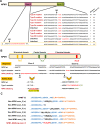Identification of a novel NPM1 mutation in acute myeloid leukemia
- PMID: 37794441
- PMCID: PMC10548603
- DOI: 10.1186/s40164-023-00449-4
Identification of a novel NPM1 mutation in acute myeloid leukemia
Abstract
Nucleophosmin (NPM1) is a widely expressed nucleocytoplasmic shuttling protein with prominent nucleolar localization. It is estimated that 25-35% of adult patients with acute myeloid leukemia (AML) carry NPM1 mutations. The classic NPM1 type A mutation occurs in exon 12, which accounts for 75-80% of adult patients with NPM1-mutated AML. It produces an additional leucine and valine-rich nuclear export signal (NES) at the C-terminus, and causes aberrant cytoplasmic dislocation of NPM1 protein. Notably, emerging evidence indicates that besides the classic type A mutation, rare mutants occurring in other exons may also lead to the imbalance of the nucleocytoplasmic shuttle of NPM1. Identification of novel non-type A mutants is crucial for the diagnosis, prognosis, risk stratification and disease monitoring of potential target populations. Here we reported a novel NPM1 mutation in exon 5 identified from a de novo AML patient. Similar to the classic type A mutation, the exon 5 mutation had the NPM1 mutant bound to exportin-1 and directed the mutant into the cytoplasm by generating an additional NES sequence, resulting in aberrant cytoplasmic dislocation of NPM1 protein, which could be reversed by exportin-1 inhibitor leptomycin B. Our findings strongly support that besides the exon 12 mutation, the exon 5 mutant is another NPM1 "born to be exported" mutant critical for leukemogenesis. Therefore, similar to the classic type A mutation, the identification of our novel NPM1 mutation is beneficial for clinical laboratory diagnosis, genetic risk assessment and MRD monitoring.
Keywords: Aberrant cytoplasmic dislocation; Acute myeloid leukemia; NPM1 mutation; Nuclear export signal; Prognosis.
© 2023. YUMED Inc. and BioMed Central Ltd.
Conflict of interest statement
The authors declare that they have no competing interests.
Figures


References
-
- Verhaak RG, Goudswaard CS, van Putten W, Bijl MA, Sanders MA, Hugens W, et al. Mutations in nucleophosmin (NPM1) in acute myeloid leukemia (AML): association with other gene abnormalities and previously established gene expression signatures and their favorable prognostic significance. Blood. 2005;106(12):3747–3754. doi: 10.1182/blood-2005-05-2168. - DOI - PubMed
-
- Koh Y, Park J, Bae EK, Ahn KS, Kim I, Bang SM, et al. Non-A type nucleophosmin 1 gene mutation predicts poor clinical outcome in de novo adult acute myeloid leukemia: differential clinical importance of NPM1 mutation according to subtype. Int J Hematol. 2009;90(1):1–5. doi: 10.1007/s12185-009-0350-1. - DOI - PubMed
Publication types
Grants and funding
- 23141902700/2023 Science and Technology Innovation Plan of Shanghai Science and Technology Commission
- 226-2022-00003/the Fundamental Research Funds for the Central Universities
- Y23H080018/Natural Science Foundation of Zhejiang Province, China
- 2022C03005/Key research and development program of Zhejiang Province, China
LinkOut - more resources
Full Text Sources

